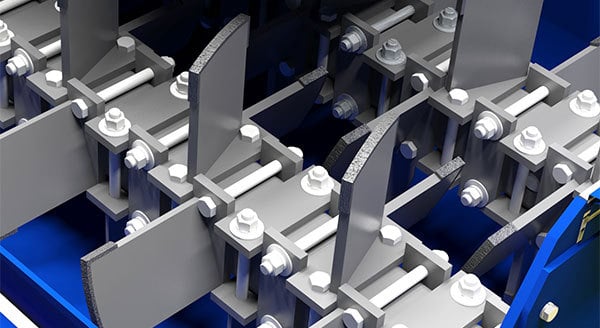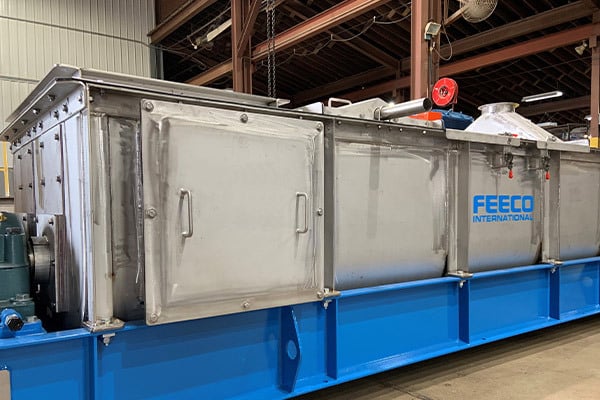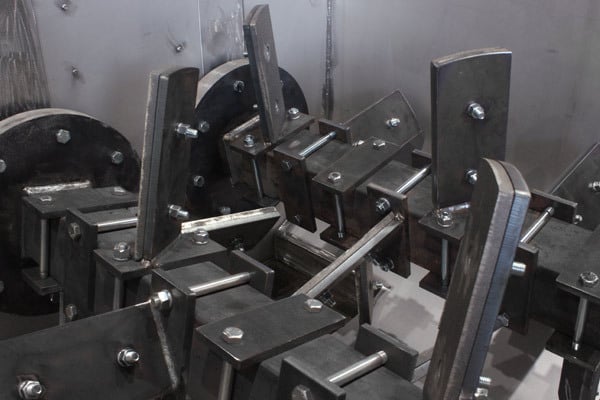Pugmill mixers are a type of continuous mixer used throughout several industries to accomplish agglomeration, mixing, and conditioning of bulk solids. They have become a critical processing device in a number of industrial settings, granulating organic materials, conditioning sludge and ash by-products for disposal, and combining material feedstocks for downstream processing.
Because these mixers are often employed in high-capacity settings, buyers are often focused on minimizing downtime. Through thoughtful design considerations, pugmill mixers offer ample opportunity for customization in a way that streamlines maintenance and minimizes associated downtime.
The following information illustrates many of the ways in which pugmill mixers can be customized for improved accessibility, ease of maintenance, and minimized downtime.
Easily Interchanged Components
While pugmill mixers generally do not require regular replacement of key components, they are often employed in settings subject to severe processing conditions where component replacement is more common.
One of the best ways to minimize the time devoted to pugmill maintenance in these cases is through the use of easily interchanged components, particularly the shafts and paddles, which present the most frequent potential for wear in high-demand environments.
Pugmill Mixer Shafts
For those with frequent shaft change-out requirements, FEECO offers a unique flanged-shaft design; unlike a standard shaft configuration where bearing and drive components must be removed in order to take out the shaft, this design allows maintenance personnel to unbolt and replace only the interior portion of the shaft, leaving all other components in place. This significantly cuts down on the time it takes to replace a shaft.
Paddles & Paddle Facings
Paddles and paddle facings can also be designed for easy changeout. Paddles are already configured for easy paddle replacement as a way to streamline adjustments to paddle arrangement, simply bolting on to the shaft. Paddle facings can also be designed for routine replacement.

The image above illustrates how paddles are bolted on to the mixer shafts.
Alternative Materials of Construction
Pugmill mixers are typically constructed of carbon steel. While this is suitable for many applications, those looking to reduce the potential for buildup, fight corrosion, and expedite the clean-out process can opt for stainless steel or other alloys. This is beneficial in settings where upstream process upsets are common, or where it is necessary to clean out the mixer between production runs.
Optional Features That Simplify Mixer Maintenance Tasks
Several additional features are available for reducing the time devoted to pugmill maintenance:
Bottom doors
One of the most time-consuming aspects of mixer maintenance is cleanout; emptying the mixer by hand so that it may be cleaned not only takes a significant amount of time, but it also increases the potential risk of injury to employees since they are working in the mixer trough.
To simplify the process, pugmill mixers can be provided with drop-bottom doors, allowing operators to simply open the doors, causing the material to drop out and substantially reducing the amount of time devoted to cleanout.
Drain
One or more drains can also be incorporated into the trough to allow for easy draining during the washout process.
Access Doors
Access doors can also be used to improve accessibility and cleanout (as well as to observe or monitor mixer operation).

FEECO Pugmill Mixer with side access door
Vents
When working with a particularly dusty application, pugmill mixers can be equipped with a venting system. This system creates a negative pressure in the mixer and pulls any fugitive dust out of the unit, preventing operators from having to manage dust during times of maintenance or cleanout.
Automation & Instrumentation
Adding automation to a pugmill mixer can be a powerful time-saver in minimizing maintenance. Mixers can be equipped with functionality to record and trend data. Operators can use this data to predict problems before they occur, or the system can be programmed to alert operators if specified parameters fall out of spec. This often averts unexpected process upsets and shutdowns. The system can even be designed to allow operators to respond to a potential issue in real time, right from the user interface.
Further, this data can provide valuable information to operators so they can more quickly resolve any recurring issues by reviewing historical data.
Different types of instrumentation can also be incorporated into the pugmill mixer system as safeguards to avoid a major upset when conditions change or a problem occurs. For example, in the event that a shaft stops turning, a zero-speed switch can be programmed to alert the operator or shut down the unit. Similarly, electronic shock relays can detect when the shaft might be in danger, such as a high-amp situation, and shut down the unit. Bearing temperature monitors are also available. While a shutdown is still necessary, the larger task of having to replace the mixer shaft and any other damaged components is avoided.
Mobility
Although it is not common, some special settings may require the mixer to be quickly taken offline and accessed. This can be achieved by mounting the mixer onto a movable platform, allowing operators and maintenance personnel to quickly slide the unit out of place for access and remove it from the production line.
Other Maintenance Considerations
While the aforementioned customizations cover mixer design, there are a few other ways to ensure streamlined mixer maintenance:
Keep a Stock of Wear-Critical Parts
Keeping a stock of wear-critical parts prevents days and even weeks of waiting on parts, allowing production to resume as quickly as possible.
Enlist a Thorough Preventative Maintenance Program
Pugmill mixers are generally low maintenance, but they still require routine upkeep and inspection to keep them in proper working order.
Work with the mixer OEM to define an appropriate schedule for preventative maintenance tasks and inspections. Consider having the OEM conduct an annual inspection to assess overall condition of the unit and identify any potential problem areas.
A solid preventative maintenance program is the first step in preventing excessive downtime and avoidable maintenance costs in the long run.
Keep Detailed Inspection & Repair Records
As part of a preventative maintenance program, keep detailed inspection, maintenance, and repair records. In addition to providing valuable benchmark data for future maintenance planning, this helps to maintain accountability and catch problems before they have the chance to escalate.
Records should include the date of inspection (or service), along with who carried out the work, exactly what was done, the condition of the assessed components, and any supplies used.
Conclusion
Pugmill mixers are readily customizable for streamlining maintenance, with easily interchangeable parts, options in materials of construction, and a range of optional features. Combined with a stock of wear-critical parts, a thorough preventative maintenance program, and detailed records, plant managers can effectively simplify maintenance and minimize downtime.
FEECO is the leading provider of custom pugmill mixers, each engineered around the unique challenges of its intended application. In addition, the FEECO Innovation Center offers testing programs for assessing pugmill mixer performance with a given material and our Customer Service Team helps our clients keep their mixers running their best. For more information on FEECO pugmill mixers and related services, contact us today!



